Welcome to the Municipality of Nafplion, where the squares and parks of the city are vibrant meeting places and nature.
Start your tour from the historic Syntagma Square, the centre of social life in Nafplio. Surrounded by beautiful neoclassical buildings and picturesque cafes, the square offers a lively atmosphere, ideal for moments of relaxation and enjoyment of the urban landscape. Continue with a visit to the Three Admirals Square, where history meets nature and creates a magical setting.
Also explore the city’s green parks, such as Kolokotronis Park, an oasis of tranquility and greenery in the heart of Nafplio. Walk among the plane trees and flowerbeds, enjoying the natural beauty and tranquillity that the park offers. Visiting the squares and parks of Nafplio is a wonderful opportunity to discover the vibrant side of the city and experience the beauty of nature in an urban environment.
Kolokotronis Park
The centre of the park is dominated by a monumental statue on horseback: the hero of the Greek revolution, Theodoros Kolokotronis. It is one of the most important works of neo-Hellenic sculpture and was created by the Tinian sculptor Lazaros Sochos in Paris.
It is made of a copper alloy and is placed on a monumental stone pedestal. The ‘old man of Moria’, as Theodoros Kolokotronis was known, is depicted on horseback, holding the reins in his left hand and showing the way forward with his right. The whole work is impressive and the proud form of Kolokotronis exudes an air of greatness.
The cost for the acquisition of the statue was exceptionally high, and a nationwide appeal was necessary to raise the funds. It was moulded in 1894 at the Thiebaut foundry in Paris and in 1895 it was transported to Greece. The pedestal, a donation from the appeal court judge, Nicholas Kotsakis, was designed in Paris by the brothers Tiero and was constructed in 1900 in Athens at the marble workshop of Ioannis Chaldoupis.
The statue was unveiled in 1901. A similar statue, by the same artist, can be found in Athens in front of the old parliament building.
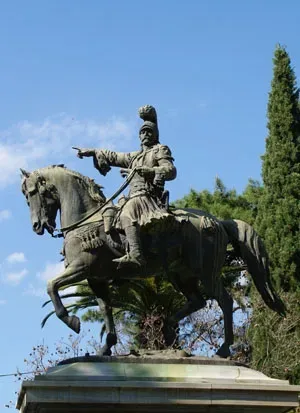
Theodoros Kolokotronis, one of the most important figures in the Greek struggle for freedom, lived in Nauplion for many years, as did many of the well-known wartime leaders. In fact he was given a house in Syntagma Square, as well as land near the entrance to the city, in the modern Argous Street, together with the Chapel of Aghii Theodori, which survives to this day.
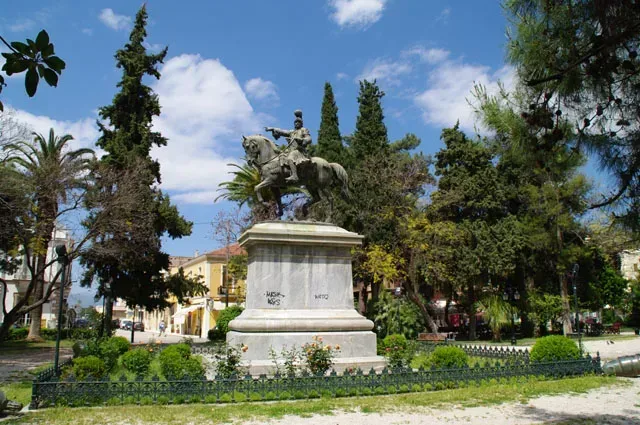
The exact location of Kolokotronis Park can be found below.
Geographical Coordinates
Kolokotronis Park, Nafplio
- Google Map
- 37.566050055417804, 22.802207132444273
The OSE Park – The Municipal Odeon
The old railway station, simply known as ‘the station’ by the locals, is one of the most beautiful sites in the city and is on the boundary of the old city of Nauplion with the new.
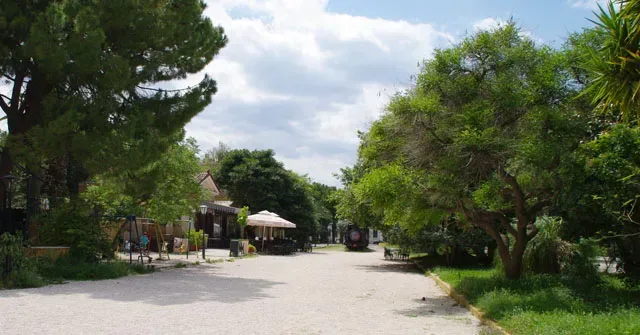
Until the beginning of the 18th century this area, which was outside the city walls, was flooded by the sea. Around 1720, during the 2nd Turkish occupation of Nauplion, the Turks reclaimed the land building banks which they landscaped with flower gardens and ‘golden pavilions’, designed for the Turkish agas.
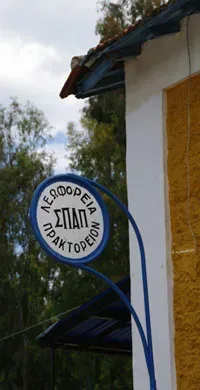
In 1884, the site was chosen for the building of the city’s railway station. The following year the buildings were completed and in 1886 the first regular service to Athens began.
The service ran until 1963. 30 years later, in 1993, the line came back into service, but Nauplion station had been moved to the port. Today the site of the old station operates as a recreation area, with flowerbeds, old trains and a refreshment stand.
The old station building now houses the municipal Odeon, ‘Konstantinos Nonis’, which makes an important contribution to the artistic life of the city.
In the other building, which was the old station warehouse, the Peloponnesian Folk Art Foundation has created a museum space dedicated to children called ‘The Stathmos’.

The exhibition that is located here deals with objects exclusively connected to children: their birth, baptism, school, and their games as both objects and activities. There are also figures from puppet shows and the famous Karagiozi shadow puppets. At the same time, ‘The Stathmos’ operates as a location for pioneering educational programmes.
In the entrance to the museum there is an original toy-sculpture called ‘the Plagona’, or doll; the work of Maria Loizidou. The work is based on both ancient and medieval prototypes. The female form symbolises the mother god and has a large eye which watches and protects.
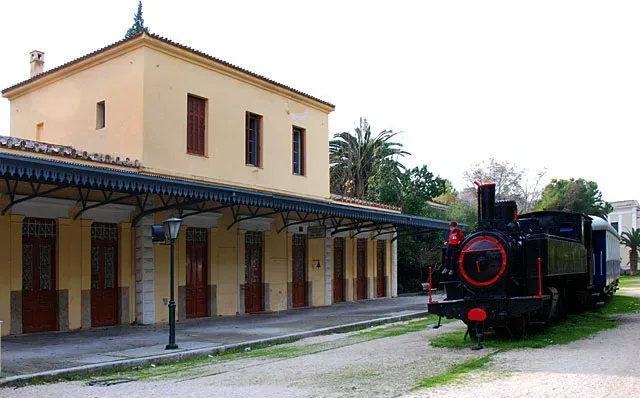
The exact location of the O.S.E. Park can be found below.
Geographical Coordinates
O.S.E. Park – Municipal Conservatory, Nafplio
- Google Map
- 37.63203113526043, 22.72361254471595
Kapodistrias Square
This square takes its name from the figure who above all others is synonymous with the history of the city: Ioannis Kapodistrias, the first governor of the modern Greek state.
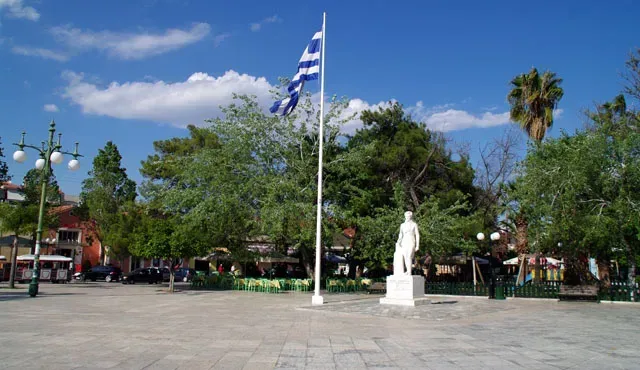
More or less on the spot now occupied by the park today there was the bastion of Dolfin, or San Marco, which was demolished as part of the wider demolition of the walls and bastions of the lower city.
The statue of the governor, the work of the sculptor Michael Tobros, was placed in the square in 1932 and is carved from marble. Kapodistrias is shown standing, dressed in formal attire, leaning lightly on the trunk of a tree.
Born in Corfu in 1776, Ioannis Kapodistrias was the son of a noble family. He studied medicine in Italy, but was finally won over by politics and diplomacy. For many years he was at the forefront of European diplomacy, chiefly as the Russian Minister of the Exterior, during which time he was able to give timely assistance to the Greek struggle for indePentence.
In April 1827, the 3rd National Congress elected him as governor of the country for a period of 7 years, and he landed in Nauplion, the then capitol, on 8th January 1828. He governed the newly constituted Greek state for 3 years and 8 months, until 27th September 1831, when he was murdered outside the church of Aghios Spiridonas.

His career as governor was bright, and it is not by chance that he is considered one of the greatest politicians in Greek History.
The exact location of Kapodistria Square can be found below.
Geographical Coordinates
Kapodistria Square, Nafplio
- Google Map
- 37.566064700824285, 22.800734165483266
Syntagma Square
Syntagma Square, the most important and historic square in Nauplion, comprises the centre of the city. It is assumed that from 1540, the time of the first Turkish occupation, the Turkish commander of the Peloponnese, Mora-Pasha, had his seraglio here.
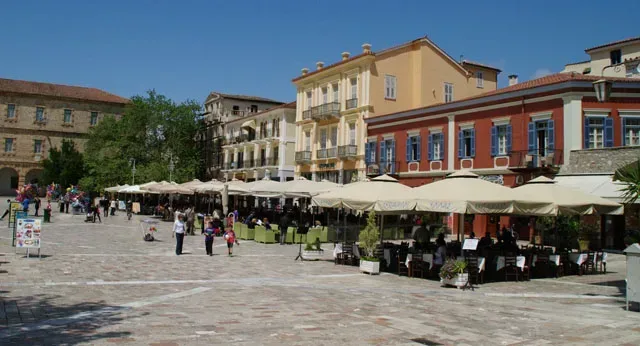
The importance of the square is also demonstrated by the number of times it has undergone a change of name. In the 19th century it was known as ‘Platanos Square’ or simply ‘Platanos’, for the plane tree which once occupied the centre, in the shade of which national politicians made speeches. In 1843 the name was changed to ‘Ludwig Square’, in honour of Ludwig, father of King Otto, who had then visited the city. In the same year, after the revolution of 3rd September 1843, when the Greeks demanded that Otto grant them a constitution, the name was changed first to Syntagma (or constitution) Square, then ‘Stratonas Square’, and ‘King George II Square’.
Today, one can see many important historic buildings in the square, such as the Venetian Warehouse of the Fleet, which today houses the Archaeological Museum; the parliament, former mosque of Aga-Pasha and finally the Allilodidaktiko School, which came to be known as the ‘Trianon’.
The square was also once home to the residences of many of the great fighters of the Greek revolution, such as Nikitaras and Theodoros Kolokotronis.
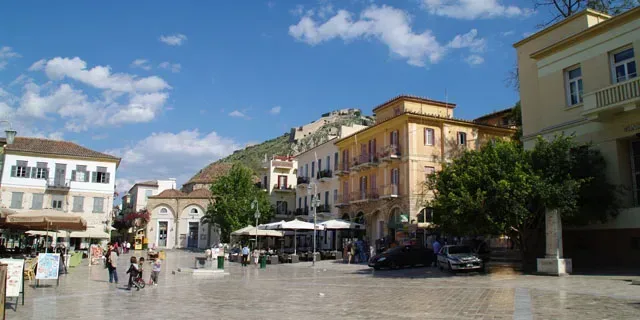
The episode known to modern Greek history as ‘Psorokostaina’ took place here. In 1826, when the rebellious Greek nation was in dire financial need, the man who became known as the teacher of the nation, Georgios Gennadios, delivered a moving speech from under the plane tree, encouraging the people of Nauplion to contribute to the appeal for the nation. His speech was so moving that the poorest woman in the city, known mockingly as ‘Psorokostaina’, gave all her possessions, which were nothing more than a silver ring and a gross.
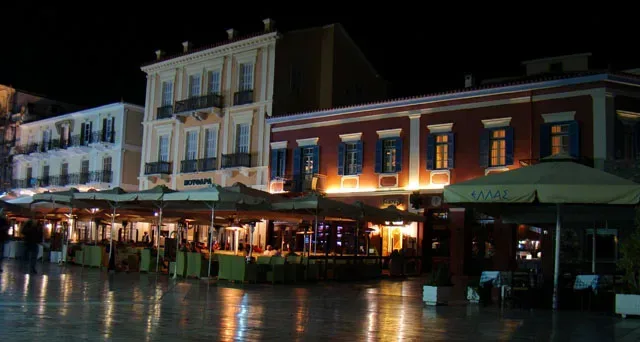
On the spot where the National Bank now stands, there was once the home of Kalliopi Papalexopoulou, which was built after the liberation of the city from the Turkish yoke. Mrs Papalexopoulou, the wife of the mayor of Nauplion, Spyridon Papalexopoulos, was at the head of the revolutionary movement for the removal of King Otto from Greece. In fact, it is said that her home was the centre for the organisation of the Nauplian revolution, which lasted from February to March 1862. Today, there is a monument to her memory outside the National Bank.
The building of the National Bank dates from around 1930 and is the work of architect Zouboulidis. It has been influenced by the palaces of Mycenae, and is only a step away from the neo-classicism of the 1930s.
The exact location of Syntagma Square can be found below.
Geographical Coordinates
Syntagma Square, Nafplio
- Google Map
- 37.56621188291986, 22.796738245279784
Philellinon Square
This square was once the site of the Venetian bastion of Santa Teresa, which was later renamed the bastion of Moschos, and was demolished in 1866.
Themonument to the Philhellenes, in other words the friends of Greece, which dominates the centre of the square, was competed in 1903, inmemory of the French Philhellenes who fought and died for theliberation of Greece from the Turkish yoke during the Greek revolution.
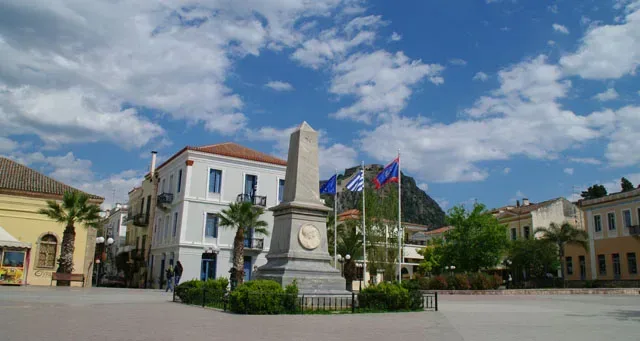
The monument, is in the form of a memorial stone made of grey marble, and is in the shape of an obelisk, a form highly popular at the time. It was designed in Paris, but constructed in Greece in the marble works of Ioannis Chaldoupis. On one side of the raised base of the obelisk there is a relief in white marble depicting the personalised forms of Greece and France, in the forms of Athena and Liberty respectively. On the eastern side of the base there is an inscription in memory of the great French Philhellenes: Field Marshall Meson, General Fabvier and Admiral Derigny, and all the French sailors and soldiers who fought for Greek indePentence.
More recently, a bust was placed on the North West side of the square in the likeness of Mando Mavrogenous, a heroine of the Greek revoloution, who lived in Nauplion from 1824 to 1831.
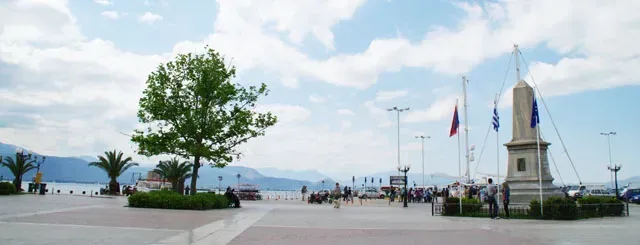
On the North East side of the square, in King Otto’s Street, there is an important two-storey neo-classical building from the 19th century, which belonged to the Iatrou family, who were well known benefactors to the city. The town hall was housed here from 1972 until its recent move to Trion Navarchon Square.
Geographical Coordinates
Filellinon Square, Nafplio
- Google Map
- 37.567329538236585, 22.796257657964542
The Three Admirals’ Square
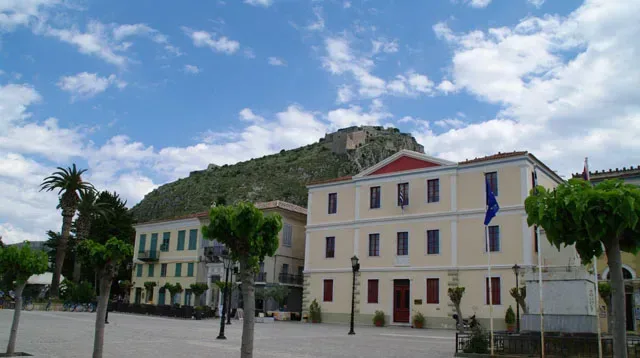
Trion Navarchon Square, the Square of the Three Admirals, is dedicated to the memory of the admirals: Kodrington of England; Derigny of France and Hayden of Russia, who fought the Turko-Egyptian fleet in the sea battle of Navarone on the 8th October 1827.
The square was constructed in the time of the governor of Greece, Ioannis Kapodistrias, by the civil engineer Stamatis Voulgaris, and includes many interesting buildings and monuments.
In the middle of the square is the funeral monument containing the remains of Dimitrios Ypsilandis, one of the leaders of the Greek revolution. Ypsilandis, who died as the result of a chronic hereditary illness at the age of 40, was originally buried in the narthex of the church of Aghios Georgios. However, in 1843 the remains were re-buried, during an official ceremony, in this monument, which was created in Vienna, following a commission by his brother, Georgios Ypsilandis.
There are many splendid neo-classical buildings in the square, among which the building which today houses the town hall stands out. Next to this, at 32 Vasileos Konstadinou Street, is the pharmacy which belonged to the Italian Philhellene, Bonifatsio Bonafin, who embalmed the body of the murdered governor, Ioannis Kopadistrias.
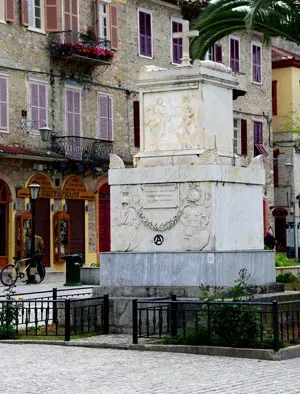
Behind the monument to Ypsilandis, in the western section of the square, one can see the statue of the first king of Greece, Otto, the second son of Ludwig I of Bavaria. The young king arrived in Nauplion on 25th January 1833, and remained in the city for a short while until 1834.
More or less on the site where the statue of Otto now stands, between Vasileos Konstadinou and Amalia’s Street, there was once one of the most important buildings in Nauplion, the Governor’s Mansion, otherwise known as ‘the Palataki’, or ‘little palace’ which was destroyed by fire in 1929. The Governor’s Mansion was built in 1829, exactly 100 years before it was destroyed. It was designed by the Italian architect, Pasquale Ippoliti, for the offices of the then newly-formed government and the residence of the first governor of Greece, Ioannis Kapodistrias.
The construction was paid for by the governor himself, with some help from donations from Greek expatriates. Both its exterior and interior had an air of austerity. It was a neo-classical building with emphasis on the horizontal axis. The interior was noticeable for the sparseness of furnishings, following instructions from the governor himself.
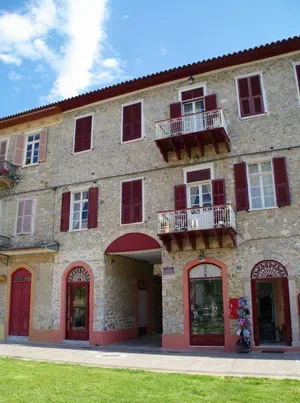
When Kapodistrias was murdered, it was here, in the central hall, that the embalmed body was placed for public viewing.

Geographical Coordinates
Three Admirals Square, Nafplio
- Google Map
- 37.56996006195933, 22.80052761543141